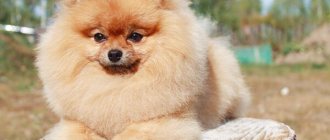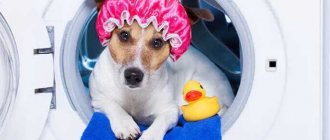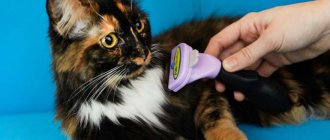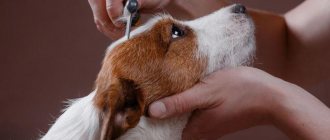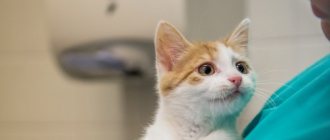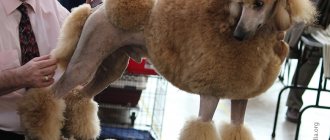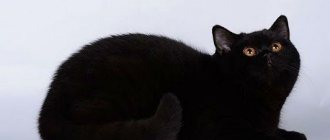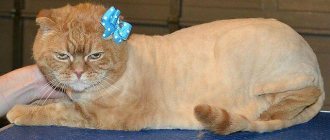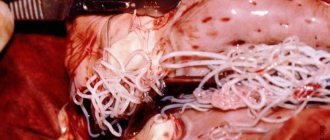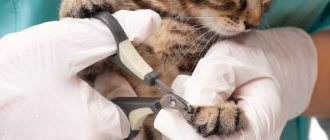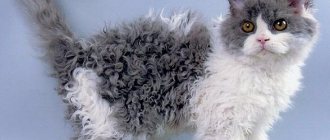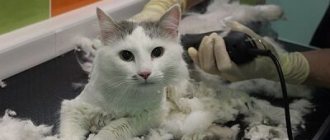Cats are very clean animals, and they usually take great care of their own hygiene. However, there are times when an animal needs human help. If for some reason a cat cannot take care of itself, or it definitely needs a haircut, the owner can seek the services of a groomer. Let's consider what grooming is, why it is needed, its pros and cons.
What is grooming
For many, the word grooming is strongly associated with cutting an animal. Actually this is not true. Grooming is a set of measures for caring for the skin and fur of an animal; it also includes caring for the cleanliness of the cat’s eyes, ears, teeth and claws. These procedures can be carried out by a specially trained person in a special salon, or the owner himself can do them.
Cats are quite clean, and therefore they do not need much special care. They rarely get haircuts; often they are needed only by certain groups, or according to indications. Most often, owners of animals who participate in exhibitions turn to the services of groomers. In this case, the pet is scheduled to see a specialist in advance. It should look perfect for the exhibition. The owner can deal with the departure of an ordinary pet on his own. The main thing is to accustom your pet to hygiene procedures from childhood.
If the owner himself cannot cope with grooming, but also does not want to worry the pet too much, a groomer can be called to the house. In a familiar environment, it will be much easier for the cat to endure all the procedures. In addition, there will be no unnecessary stress due to visiting unfamiliar places.
A set of grooming activities
Animal care procedures can be carried out both at home and in a special salon. The first option is more acceptable, since the animal experiences less stress during the procedures. However, the salon has a lot more special tools and equipment that you can’t always take home with you.
The set of grooming activities includes the following activities:
- ear cleaning;
- rubbing the eyes (in some breeds with very watery eyes, this procedure must be carried out regularly);
- teeth cleaning (carried out using special paste and brush);
- maintaining the optimal length of the claws (a special nail clipper is used to shorten the claws);
- bathing the animal;
- a haircut.
Required Tools
To groom a cat you will need the following tools:
- long-toothed comb;
- a slicker brush is needed to comb out all the fallen hair;
- nail clipper;
- cotton pads and sticks;
- special toothbrush and toothpaste;
- antiseptics in case the animal gets injured during hygiene procedures;
- scissors;
- trimmer.
It is not recommended to cut tangles with scissors. It is very easy to injure an animal this way. And trying to untangle them is also not a good idea. Due to the special structure of wool, this is impossible. A trimmer is best for removing tangles.
You should not use any human products when caring for your cat. Toothpaste has too strong a smell and can cause irritation, and human shampoo is not suitable for a cat. A human toothbrush has too hard bristles. If there are no other options, you can use a brush for very young children. It is better to purchase all other products at a veterinary store in the cat products section. .
Combing
To make the combing process go faster, you need to apply a special spray to the pet's fur to help comb it.
- In order to comb your pet you must have a special brush.
- There is also a special glove for grooming cats, which makes the combing process faster. It is convenient to cut hair with it.
- You hold your pet with one hand and comb it with the other. It should be combed in the direction of hair growth.
- The glove itself is made of fabric, and the part that combs is made of silicone with bristles. She doesn't just comb, she also massages the pet.
- Cats love this procedure. Doesn't hurt when combing.
Cats with long hair are brushed more often than cats with short hair. When cats are shedding, it is recommended to brush them every day.
Types of grooming
Depending on the goals pursued by the owner, the following types of grooming can be distinguished:
- Hygienic. The animal is bathed, its eyes and ears are cleaned, its claws are trimmed, and its teeth are brushed. The wool is cut in the groin area and on the stomach so that it does not get dirty so much. Trim the hairs between the pads and fingers.
- Home. This type includes all the procedures that the owner carries out with his pet at home: combing the fur, trimming the claws, cleaning the eyes and ears, bathing. In addition, the owner can cut off the tangles formed on the cat’s fur himself.
- Exhibition. Although it is not recommended to bathe cats frequently, they are thoroughly cleaned before exhibitions. In addition, the cat can be given a neat haircut, which is necessary to emphasize all the advantages of this animal and give the coat a neat appearance.
- Creative. Cats are given rather unusual hairstyles, cutting out entire patterns and giving their fur an unusual look. It is not advisable to do this for “beauty”, but if the animal needs a haircut in any case, then its fur can be given an unusual shape.
We recommend the article: Traveling with a cat: important tips for trips and trips
To cut or not to cut
It is important to understand that not all cats can and should be subjected to this procedure. So the following are a kind of contraindication:
- colorpoint and tipping colors - as the fur grows on the back and belly, it will become several tones darker than before cutting;
- disgusting character and violent temperament, when the animal does not give in to any persuasion. Of course, you can cut it under anesthesia, but in this case, evaluate all the possible risks associated with the administration of narcotic drugs: cardiac arrest, coma, failure of the liver and kidneys. As a last resort, sedatives and muscle relaxants are used instead of drugs, but only after approval of the appropriateness of their use by a specialist and under his clear guidance;
- Without an urgent need, there is no point in cutting short-haired cats - the heat does not particularly interfere with normal life activities, and they never have mats;
- Smooth-haired animals are cut only in extreme cases, for example, when they have been worn in oil paint and it is easier to shave the animal than to try to rub off the matted multi-colored wool.
Necessity of grooming
There are cats that cannot cope with their own hygiene. There may be several reasons for this:
- elderly age;
- excess weight;
- health problems;
- hormonal surges during the period of sexual hunting.
And completely healthy animals require the care of their owner. It is not advisable to frequently bathe a healthy animal, since it is often a lot of stress for the cat, and frequent exposure to chemicals can lead to skin irritations. The cat is bathed if there is any contamination, before shows and as indicated by the veterinarian. If you need to apply a special product to your skin. In this case, you should make sure that the animal does not freeze or catch a cold after bathing. If the cat experiences very strong stress from contact with water. You should avoid swimming altogether. Dirt can be removed using wet wipes.
Some breeds are prone to having very watery eyes. Therefore, they must be periodically wiped with a clean cotton pad moistened with boiled water. It is necessary to periodically inspect your pet's ears and remove dirt from them with a cotton swab.
Veterinarians strongly do not recommend surgery to completely remove the claws. But you can trim them periodically. Especially if the animal does not actively use the scratching post. When trimming nails, be careful as blood vessels can easily be damaged. Just in case, you should prepare an antiseptic and cotton pads.
Owners rarely bother with brushing their pet’s teeth. As almost all cats age, they develop tartar, which can lead to gum disease. That is why this procedure should not be neglected. You should be accustomed to brushing your teeth from childhood, this is the only way your pet will normally accept this not very pleasant procedure.
Cats, especially those with long hair, need to be brushed regularly. To do this, you can use special combs that will help remove lost hair and slicker brushes. This way the pet will look neater, and it won’t swallow so much fur while licking. In addition, there will be much less hair on the furniture. During the shedding period, it is advisable to comb your pet every day.
Grooming cats is an issue that causes a lot of controversy. Many veterinarians and breeders advise cutting an animal's hair only when absolutely necessary. This is due to the fact that the event itself can cause considerable stress in the animal. Short haircuts can lead to disruption of heat exchange, and the undercoat may never fully recover. In addition, many cats undergo haircuts under anesthesia, which has a very bad effect on the health of the animal.
There are some breeds whose special coat structure leads to the formation of tangles. Theoretically, this problem can be solved by combing the animal every day. However, even this does not always help. Mats easily absorb dirt and can emit an unpleasant odor, irritation can form on the skin underneath them, and the cat can also swallow the mat while licking, which can lead to intestinal blockage.
We recommend the article: Proper care of a furry pet: where to start?
Grooming of cats is also recommended for the following reasons:
- The animal is very hot, and this problem cannot be solved by other methods. If it is impossible to reduce the temperature in the room, then haircuts are used for long-haired animals.
- The animal will undergo medical procedures or surgery. In this case, the wool is clipped only in the right places.
- The animal has a skin disease, for the treatment of which it is necessary to cut the hair. In this case, the procedure is carried out in a veterinary clinic.
- The cat swallows too much hair. This often happens in long-haired breeds. Often the hair itself easily comes out of the body, but in some cases this does not happen.
- The animal needs to be combed very often, and in extreme cases, trimmed.
When not to cut your cat's hair:
- The animal has serious skin problems.
- The cat experiences a lot of stress during the grooming process.
- If the house is cold. The animal will begin to freeze and may catch a cold.
- The cat has serious health problems, for which unnecessary worries are contraindicated.
Even if you really want to give an animal a fashionable and unusual hairstyle purely for aesthetic reasons, this idea should be abandoned. First of all, you need to be guided by the interests of your pet, and not by your own desires.
Why cut your cat's hair?
After clipping, the coat is easier to comb.
In fact, the procedure is quite popular and in demand in grooming salons. Yes, there are owners who bring their favorite furry dogs for a haircut in order to win at the exhibition, have an extravagant look and have cute photos for Instagram or social networks.
But there are also those who know that such hairstyles have many advantages for the health of their children. What are the advantages of a unique hygiene procedure?
- getting rid of tangles, which have become too numerous and can no longer be untangled with ordinary brushes;
- normalization of digestion: unsightly and hanging hairballs, disfiguring the cat, can cause blockage of the stomach and intestines if accidentally swallowed during another lick;
- order in the house: after a haircut, the wool does not lie everywhere and does not cause the owner to have bouts of quiet rage when, once again, black pants have turned into a shaggy hedgehog;
- easier combing;
- peace of mind between the cat and the person: you won’t have to tyrannize your pet and freak out from the daily tearing apart of tangled areas of fur;
- relief from suffering: in summer the animal will no longer suffer from the heat.
By the way, the presence of tangles is the cause of dermatological problems: the skin under them heats up more, creating favorable conditions for the development of pathogenic microflora. Frequent formation of “felt balls” indicates a metabolic disorder or vitamin deficiency and requires consultation with a specialist.
Pet behavior
Most hygiene procedures can become a real stress for a cat if it has not been accustomed to them since childhood. Therefore, from the first months the kitten needs to be accustomed to grooming procedures. You need to periodically comb him, trim his nails, clean his eyes and ears.
All this should be done carefully, without using force, otherwise the pet will be afraid of these procedures in the future. If you behave correctly with the animal, over time it will get used to it and will be patient with all manipulations.
If the animal is very nervous during the grooming process, you should not do anything by force. You cannot use force, and even more so you should refuse to use anesthesia. Some salons use it. Of course, in a dream the animal does not see or feel anything, and therefore does not stress during the haircut. However, anesthesia negatively affects the health of the animal. If the cat had hidden pathologies, it may not wake up at all.
Before grooming, it is advisable to trim your cat's claws. If she suddenly gets scared and starts to struggle, this will help avoid injury. It should also be noted that haircutting is a very long procedure that can take up to several hours. Not every animal, even the calmest one, can endure this. Therefore, it is desirable for the owner to be nearby. He will be able to distract and calm the pet if necessary.
How to cut your own hair at home
For a calm perception of the tool itself by the pet, it is recommended to first introduce the cat to the scissors, let it sniff, and study the “enemy.”
When using the tool for the first time, you need to make sure that the cat is calm and does not visually react to the scissors, and then try to make cutting movements.
When doing a hygienic haircut, the tangles are cut off first, since ordinary combs will not help here. Felt-like balls often form in the groin and armpits
Removing mats can be called a piece of jewelry, since hairballs form close to the skin and it is very important not to damage the pet’s skin
Next, the sides are cut. When working with scissors, it is not easy to maintain an equal remaining length of wool, so it is better to use a special machine if beauty is a question.
During the hygienic cutting process, you should not touch the fur on the head, paws and tail.
If necessary, the haircut can be spread over several passes so as not to create an image of danger for your pet. It wouldn't hurt to reward him with some kind of treat.
Popular haircuts
Most often, animals are given hygienic and exhibition haircuts. The first is important for maintaining the animal's hygiene, and can even be done at home. The second is done by a specialist. It is designed to hide all the shortcomings of the animal’s exterior and emphasize its advantages.
When grooming a cat, the groomer adheres to the following rules:
- The hair on the head is not touched, since without it it becomes more difficult for the animal to navigate in space.
- Do not touch the hair in the ears, as it protects them from dirt.
- You cannot cut an animal bald; you still need to leave at least a small amount of fur. Without it, the animal will begin to freeze, and direct exposure to sunlight on bare skin can lead to burns.
We recommend the article: Grooming cats: the pros and cons of the procedure
If, for certain reasons, the animal needs a more serious haircut, it can be done creatively. Just don’t try to do this haircut yourself at home. At best, you can simply ruin the appearance of your pet. In the worst case, you could damage his skin. Short haircuts are best left to the experts.
Dragon A cat's back ridge is cut out in steps or a kind of mohawk is made, while the rest of the body, except for the head and paws, is cut very short. The cat visually begins to resemble a baby dragon. Lion Leaves quite a lot of fur on the head, neck and chest, making it resemble a lion's mane. A fluffy brush is left at the tip of the tail.
Puma Only the back part of the body is cut short. The chest, head, and paws remain intact. This haircut is good if the animal is hot to normalize thermoregulation.
Preparing a cat for immobilization
There is a really workable option to immobilize a cat with a clothespin or a paper clip - essentially the same thing. The item is attached to the withers without causing pain or discomfort for the cat. Behavior is inhibited spontaneously and reactions are slowed down. The cat will better tolerate this procedure, provided that it is performed by a person close to him, or better yet, by the owner. Also, manipulation should be carried out only in case of urgent need, and not for fun. Most cats that were tried to be immobilized in this way experienced the action positively, without pain or fear. But no one is immune from the individual reaction of each individual cat.
First you need to prepare the cat for the procedure:
- If the pet is wearing a collar, it must be removed to provide free access to the cat's neck. If left on, it can create a suffocating feeling and your pet will become agitated.
- After this, you need to find the scruff. It is located on the outside of the cat's neck and looks like a loose fold. If it is difficult to feel the cat’s scruff, then it will not be easy to immobilize it. You should be extremely careful not to squeeze your cat's skin too hard.
- You need to grab the scruff of the neck with your hand and look at the pet’s reaction. If he feels completely relaxed, then he can quickly be immobilized. If the animal meows or tries to escape, then you need to try to immobilize it using another method.
You can determine that a cat is tense when he is not trying to escape by dilated pupils, intermittent breathing, and moving ears. If you grab it by the scruff of the neck closer to the ears, you can control the movement of the animal’s head. To avoid needing help when immobilizing a cat, it is better to watch a training video in advance. It's actually simple.
© shutterstock
